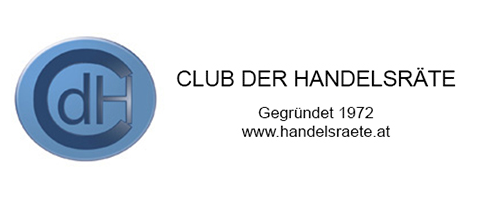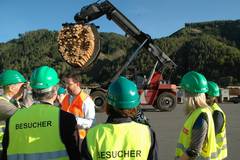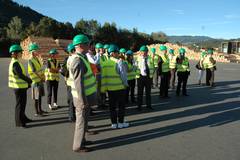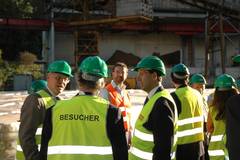Styria
Wood and industry in general were the topics of the trade delegates' trip to the province, referred to as the "Green Heart of Austria"
After arriving in Styria's capital, Graz - and a cup of coffee, of course - the trade delegates were given a presentation about Styria?s industrial base by Mag. Jochen Pildner-Steinburg (president), and Dr. Thomas Kreutzer (CEO), of the Industriellenvereinigung Steiermark (Federation of Styrian Industries): Styria exports 60% of its production, 98% of it coming from industry. A good 33% of Austria's innovations have their origin in Styria.
Styria is a land of industry, shown by the dominance of the producing sector in earnings and employment. Industry generates 37% of the regional GDP and employs half of the Styrian workforce directly or indirectly. That is why industry is the most important driver of innovation, the prime source of revenue and the biggest employer in Styria.
Traditionally, the most important industrial sectors in Styria are metal production and manufacturing, mechanical engineering, and paper and paper board manufacturing (which was the central topic of the visit programme). In the meantime, Styria has also been able to achieve market leadership in other high-tech sectors, such as vehicle manufacturing, microelectronics and electro-. Styria has the highest R&D quota in Austria, which has allowed not only these sectors to advance but has also laid the foundations for emerging technology industries, such as in the field of biocatalysis in medical engineering and in nanostructure materials.
Sappi Austria Produktions-GmbH & Co KG
The next visit was to the site of one of the world?s biggest paper production machines at the Sappi plant in Gratkorn, on the outskirts of Graz. Founded in 1793, the Austrian paper mill Leykam-Mürztaler in Gratkorn was integrated into the south African Sappi company in 1998, which now has 20.000 employees worldwide. In Gratkorn, Sappi is the biggest employer and, with growing R&D and services activities, the site is becoming more and more a CEE logistics hub within Sappi ? one of the "big 6" in CWF mills worldwide.
Two enormous machines produce 950.000 tons of coated wood-free paper which is used in publications such as annual reports, catalogues, brochures and glossy magazines. Paper machine No. 11 (PM11), about 210 meters long, is the third largest worldwide, as Dietmar Radner, previously CEO of Sappi Austria for more than 15 years, explained to the trade delegates.
Mayr-Melnhof Wood
Finally, the trade delegates had the opportunity to have look inside of one of the largest saw mills in Europe, Mayr-Melnhof in Leoben, where about 10,000 tons of fresh, dried or plain sawn timber of highest quality, are produced per year and delivered, not only within Austria, but also to the Gulf region, Middle East, and even Japan. In addition, wood briquettes and pellets are produced from the by-products sawdust and wood shavings.
The origins of Mayr-Melnhof Holz, a leading European company in the timber industry, can be traced back to the mid 19th century. The majority shareholder of the group of companies is Franz Mayr-Melnhof Saurau. Since the year 2000, a minority share of 25.1% has been held by Austrian Federal Forests.
Director Richard Metnitzer led the CdH delegation through the whole site and showed them how wood processing is managed at Mayr-Melnhof. The quality of the supplied logs, according to various criteria, is established by visual inspection on site in the Mayr-Melnhof Holz process line. Physical dimensions are measured using the latest technology in metrology. The sorted timber is collected in different bins and then processed in an environmental-friendly way. The majority of the wood processed by Mayr-Melnhof Holz comes from the region surrounding the site ? Styria, the "Green Heart of Austria".







